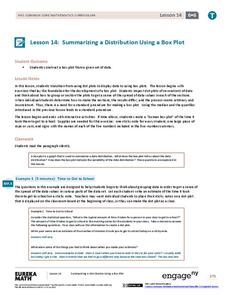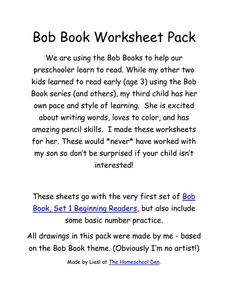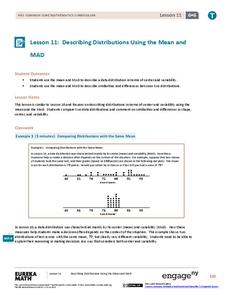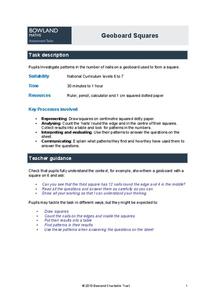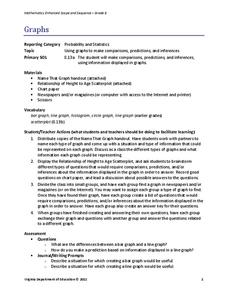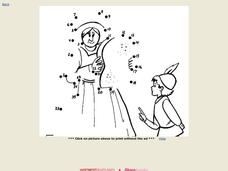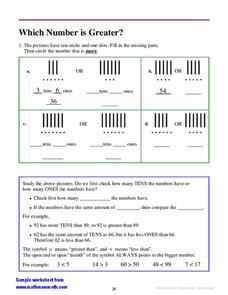EngageNY
Describing Distributions Using the Mean and MAD
What city has the most consistent temperatures? Pupils use the mean and mean absolute deviation to describe various data sets including the average temperature in several cities. The 10th lesson in the 22-part series asks learners to...
EngageNY
Understanding Box Plots
Scholars apply the concepts of box plots and dot plots to summarize and describe data distributions. They use the data displays to compare sets of data and determine numerical summaries.
EngageNY
Summarizing a Distribution Using a Box Plot
Place the data in a box. Pupils experiment with placing dividers within a data set and discover a need for a systematic method to group the data. The 14th activity in a series of 22 outlines the procedure for making a box plot based...
EngageNY
More Practice with Box Plots
Don't just think outside of the box — read outside of it! The 15th lesson in a 22-part unit provides pupils more work with box plots. Learners read the box plots to estimate the five-number summary and interpret it within the context....
Homeschool Den
Bob Book Worksheet Pack
Practice fundamental reading and number skills with a packet of worksheets for early readers. Pupils find sight words, trace letters, and complete number sequences.
EngageNY
Describing Distributions Using the Mean and MAD II
The 11th lesson plan in the series of 22 is similar to the preceding lesson plan, but requires scholars to compare distributions using the mean and mean absolute deviation. Pupils use the information to make a determination on which data...
BBC
Walking with Dinosaurs
Breath new life into your class's study of dinosaurs with this extensive collection of materials. Offering everything from a printable T-rex mask, word searches, and connect-the-dots activities to informational handouts, hands-on...
EngageNY
Comparing Data Distributions
Box in the similarities and differences. The 19th lesson in a unit of 22 presents class members with multiple box plots to compare. Learners use their understanding of five-number summaries and box plots to find similarities and...
Achieve
BMI Calculations
Obesity is a worldwide concern. Using survey results, learners compare local BMI statistics to celebrity BMI statistics. Scholars create box plots of the data, make observations about the shape and spread of the data, and examine the...
Bowland
Geoboard Squares
Don't be a square! Help your budding mathematicians discover patterns within squares. Scholars create squares on geoboards and identify patterns in the number of nails, both nails on the edge of the squares and nails within the squares....
Virginia Department of Education
Graphs
Examine different types of graphs as a means for analyzing data. Math scholars identify the type of graph from a series of data displays and then develop questions to match each one. Then, given a scatter plot of height versus age...
Curated OER
Orange Dot to Dot
For this connect the dots worksheet, students connect the dots and draw a line using the numbers 1-10 to outline the picture of a orange.
Curated OER
Lemon Dot to Dot
In this connect the dots worksheet, students connect the dots and draw a line using the numbers 1-16 to outline the picture of a lemon.
Curated OER
Apple Dot to Dot
In this dot to dot activity worksheet, students complete the connect the dots activity to trace and draw an apple. Students use the numbers 1-14.
Curated OER
Banana Dot to Dot
In this connect the dots worksheet, students connect the dots and draw a line using the numbers 1-20 to outline the picture of a banana.
Curated OER
Dragonfly Dot To Dot
In this science worksheet, 2nd graders will connect the dots from one to forty-two to create a dragonfly. Students will respond to the question and write what the picture comes to be once it has been completed.
Curated OER
Connect the Dots
In this connect the dot worksheet, students connect the dots to reveal the two kinds of mammals that lay leathery eggs instead of giving birth to live young.
Curated OER
Number Sequence 0 22
In this number sequencing instructional activity, students connect numbers from one to twenty-five and thirty-five to complete a picture. In this connect the dots instructional activity, students complete one picture.
Curated OER
Connect-The-Dots
For this math worksheet, students complete an elephant-shaped connect-the-dots picture. The numbers range from one to thirty-eight. Students may also color in the illustration when they are finished.
Curated OER
Counting to Seventeen
In this counting to seventeen worksheet, students draw lines from number one dot to number seventeen dot to complete a picture. In this drawing worksheet, students solve one problem.
Curated OER
Number Recognition 1 38
In this number recognition worksheet, learners identify numbers in sequence from one to thirty-eight. In this connecting the dots worksheet, students create one picture.
Curated OER
Connect the dots from 1 to 10
In this connecting the dots worksheet, students recognize numbers one to ten in sequence. Students connect the nine dots.
Curated OER
Which Number is Greater?
In this number comparisons learning exercise, learners study the pictures and check the ones and tens place for the numbers. Students first fill in the missing parts and circle the number that is more. Learners write in a greater or less...
Curated OER
Subtraction fact number sentences
In this subtraction worksheet, students complete subtraction word problems where they find the correct number sentence to go with the problem. Students complete 10 multiple choice questions.


